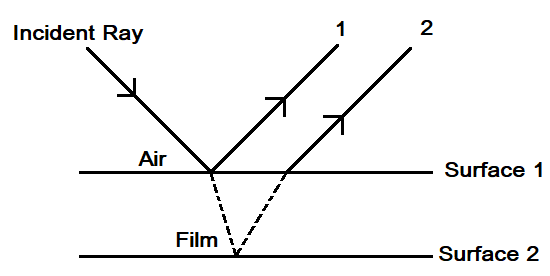
Answer
460.8k+ views
Hint: The thin-film interference method or occurrence when a light wave is reflected off from the two surfaces with the surface separation is that of the wavelength distance. Due to this occurrence, the phase differences between the two surfaces are negligible when light passes from denser to rarer. Hence, the path difference for constructive interference of transmission of light is given as:
\[2\mu t=n\lambda \]
where \[\mu \] is the refractive index, \[t\] is the thickness of the refractive surface, \[n\] is the refractive index, \[\lambda \] is the wavelength.
Complete step by step solution:
Let us draw the diagram to show how the light ray when traveling from rarer to denser medium refracts and from denser to rarer reflects from surface 1 to 2 and from 2 to 1.

Hence, there are two types of transmission of light i.e. constructive and destructive. For constructive transmission, the phase difference between the travelling of light is 180 degrees. The light from the incident ray is reflected and refracted from the first surface and second surface simultaneously. Hence, the minimum thickness for the transmission of light from surface 1 to surface 2 is:
\[2\mu t=n\lambda \]
Placing the value of \[\lambda \], as \[\lambda =600nm\], \[\mu =1.33\] and \[n=1.5\] in the formula above:
\[t=\dfrac{n\lambda }{2\mu }\]
\[t=\dfrac{1.5\times 600}{2\times 1.33}\]
\[=338.34nm\]
\[\therefore \] The thickness of the glass for the transmission from surface 1 to surface 2 is \[338.34nm\].
Note:There are two constructive Interference for reflection and transmission are given as:
For constructive Interference for reflection is:
\[\dfrac{\left( 2n\text{ }+\text{ }1 \right)\text{ }\lambda }{2}=\text{ }2\mu t\text{ }\]
For constructive Interference for transmission is:
\[2\mu t=n\lambda \]
And the value of the wavelength transmission is \[\lambda \] and not \[\dfrac{\lambda }{2}\] due to higher refractive index.
\[2\mu t=n\lambda \]
where \[\mu \] is the refractive index, \[t\] is the thickness of the refractive surface, \[n\] is the refractive index, \[\lambda \] is the wavelength.
Complete step by step solution:
Let us draw the diagram to show how the light ray when traveling from rarer to denser medium refracts and from denser to rarer reflects from surface 1 to 2 and from 2 to 1.

Hence, there are two types of transmission of light i.e. constructive and destructive. For constructive transmission, the phase difference between the travelling of light is 180 degrees. The light from the incident ray is reflected and refracted from the first surface and second surface simultaneously. Hence, the minimum thickness for the transmission of light from surface 1 to surface 2 is:
\[2\mu t=n\lambda \]
Placing the value of \[\lambda \], as \[\lambda =600nm\], \[\mu =1.33\] and \[n=1.5\] in the formula above:
\[t=\dfrac{n\lambda }{2\mu }\]
\[t=\dfrac{1.5\times 600}{2\times 1.33}\]
\[=338.34nm\]
\[\therefore \] The thickness of the glass for the transmission from surface 1 to surface 2 is \[338.34nm\].
Note:There are two constructive Interference for reflection and transmission are given as:
For constructive Interference for reflection is:
\[\dfrac{\left( 2n\text{ }+\text{ }1 \right)\text{ }\lambda }{2}=\text{ }2\mu t\text{ }\]
For constructive Interference for transmission is:
\[2\mu t=n\lambda \]
And the value of the wavelength transmission is \[\lambda \] and not \[\dfrac{\lambda }{2}\] due to higher refractive index.
Recently Updated Pages
Fill in the blanks with suitable prepositions Break class 10 english CBSE

Fill in the blanks with suitable articles Tribune is class 10 english CBSE

Rearrange the following words and phrases to form a class 10 english CBSE

Select the opposite of the given word Permit aGive class 10 english CBSE

Fill in the blank with the most appropriate option class 10 english CBSE

Some places have oneline notices Which option is a class 10 english CBSE

Trending doubts
Fill the blanks with the suitable prepositions 1 The class 9 english CBSE

How do you graph the function fx 4x class 9 maths CBSE

When was Karauli Praja Mandal established 11934 21936 class 10 social science CBSE

Which are the Top 10 Largest Countries of the World?

What is the definite integral of zero a constant b class 12 maths CBSE

Why is steel more elastic than rubber class 11 physics CBSE

Distinguish between the following Ferrous and nonferrous class 9 social science CBSE

The Equation xxx + 2 is Satisfied when x is Equal to Class 10 Maths

Differentiate between homogeneous and heterogeneous class 12 chemistry CBSE




